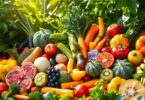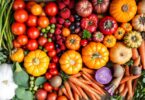In a world dominated by processed foods, a movement is gaining momentum. It focuses on raw, unaltered ingredients. A remarkable 1 in 4 Americans now adopt a plant-based diet, seeking natural, nutrient-rich nutrition. Welcome to the world of raw food, where nature’s essence is paramount, promising a transformative path to health and well-being.
The raw food movement is built on a simple yet profound belief. It posits that the closer we stay to nature, the better our bodies will function. By avoiding traditional cooking, processing, and refining, raw food advocates tap into the full potential of fruits, vegetables, nuts, seeds, and other whole foods. These ingredients, rich in enzymes, vitamins, and minerals, form the cornerstone of a lifestyle that honors the untamed power of natural nourishment.
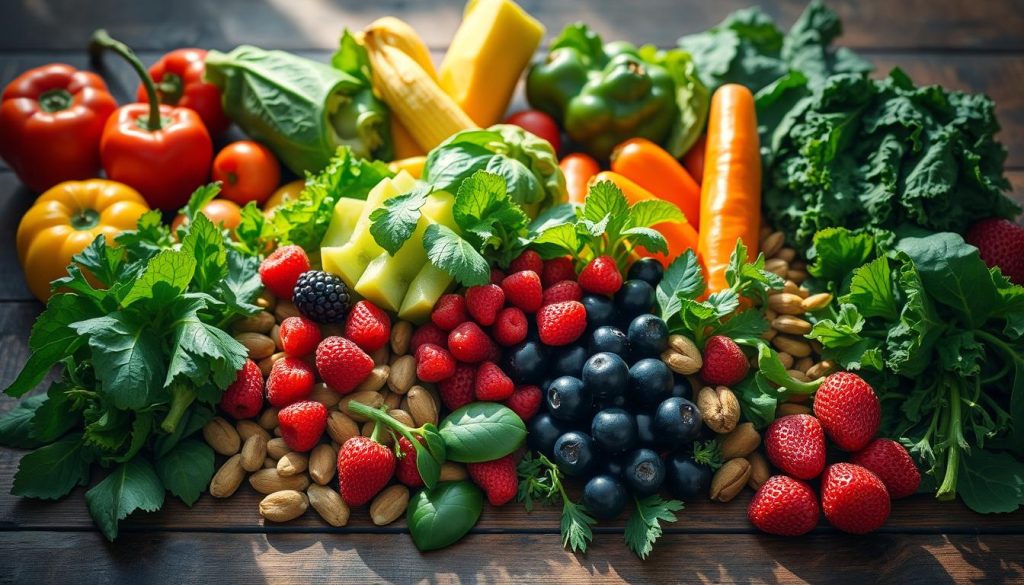
Key Takeaways
- Raw food diets focus on unprocessed, plant-based ingredients for optimal nutrition.
- The raw food movement emphasizes the preservation of natural enzymes and nutrients.
- Raw food eating is gaining popularity as a holistic approach to health and wellness.
- Transitioning to a raw food lifestyle can offer a range of potential benefits.
- Proper preparation and planning are key to maintaining a sustainable raw food regimen.
Understanding the Essence of Raw Food Nutrition
The realm of uncooked cuisine is captivating, focusing on the benefits of live foods for our health. At its core, raw food nutrition aims to keep the natural enzymes and nutrients of ingredients intact. This is key to nourishing our bodies effectively.
Defining Raw Food and Its Core Principles
Raw food, as the term implies, consists of foods that are not cooked or are lightly processed. This eating style highlights the need to retain the natural enzymes, vitamins, and minerals found in uncooked cuisine. The essence of raw food nutrition revolves around the belief in the importance of enzymatic activity and nutrient preservation for health and wellness.
The Historical Evolution of Raw Food Diets
The idea of raw veganism stretches back centuries, with figures like Hippocrates and Sylvester Graham promoting enzymatic nutrition and unprocessed, plant-based diets. The raw food movement has grown, attracting more followers who value the nutrient preservation and holistic benefits of this lifestyle.
Key Components of Raw Food Lifestyle
- Focus on whole, unprocessed fruits, vegetables, nuts, seeds, and sprouted grains
- Use of minimal to no heat or cooking methods that can destroy enzymes and nutrients
- Adoption of juicing, blending, and dehydration techniques to preserve nutrients
- Choosing organic, locally sourced, and seasonal produce
- Exploring fermented and probiotic-rich foods for gut health
Adopting the raw food philosophy allows individuals to embark on a journey of natural nutrition. It unlocks the transformative power of enzymatic vitality in their daily lives.
The Science Behind Raw Food Benefits
Adopting a raw food lifestyle is more than a personal choice; it’s backed by scientific research. Raw diets are rich in nutrient-dense, energy-boosting, and anti-inflammatory foods. These elements contribute significantly to overall health and well-being.
Raw foods are particularly beneficial for gut health. They contain unprocessed, whole foods that are high in fiber, enzymes, and probiotics. These components aid digestion, reduce inflammation, and foster a healthy gut microbiome. This leads to better nutrient absorption, enhanced immunity, and the management of chronic conditions.
Eating a diet rich in raw, nutrient-dense foods can also boost energy levels and aid in weight management. Raw foods are often low in calories but high in vitamins, minerals, and antioxidants. They provide sustained energy without the blood sugar spikes and crashes seen in processed, cooked foods.
Moreover, the anti-inflammatory properties of raw foods are crucial in combating chronic inflammation. Inflammation is linked to various health issues, including heart disease, arthritis, cancer, and Alzheimer’s. By increasing the intake of anti-inflammatory foods, individuals can lower their risk of these conditions.
In conclusion, the scientific evidence clearly indicates that a raw food lifestyle can profoundly impact health and well-being. It benefits gut health, energy levels, and inflammation reduction. The advantages of raw, whole foods make a strong case for adopting this natural approach to nutrition.
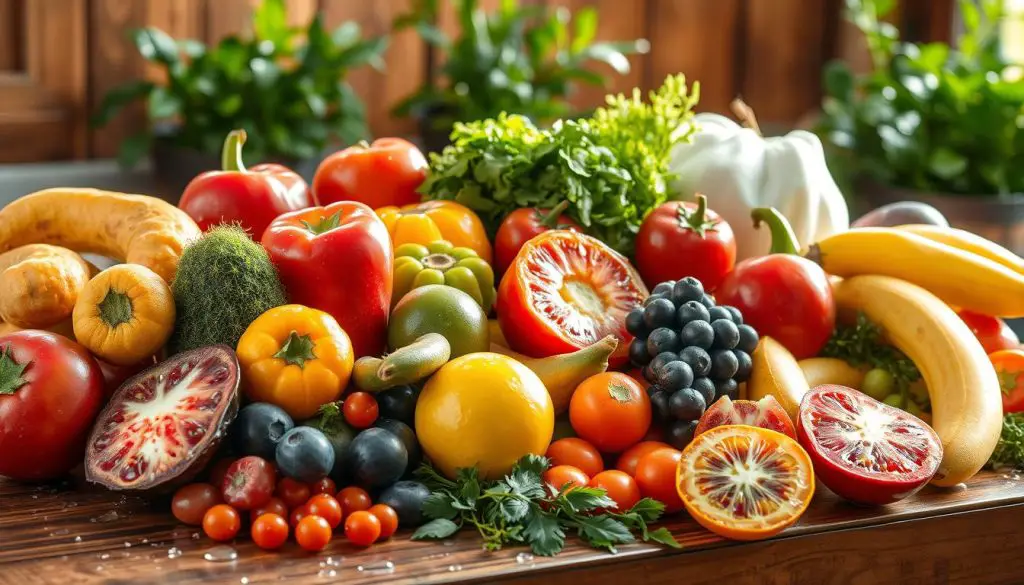
| Benefit | Scientific Evidence |
|---|---|
| Gut Health | Raw foods are rich in fiber, enzymes, and probiotics that support a healthy gut microbiome, aiding digestion and reducing inflammation. |
| Energy Levels | Nutrient-dense raw foods provide sustained energy without blood sugar spikes, helping to manage weight and boost overall vitality. |
| Anti-Inflammatory Properties | The natural compounds in raw foods have been shown to possess powerful anti-inflammatory effects, reducing the risk of chronic diseases. |
Essential Tools and Equipment for Raw Food Preparation
Adopting a raw food lifestyle demands the right tools and equipment to fully exploit the benefits of fresh, unprocessed ingredients. From high-speed blenders to specialized prep tools, a well-equipped kitchen is key. It enhances your raw food creations and simplifies meal prep.
Must-Have Kitchen Appliances
A powerful blender is central to any raw food kitchen. It transforms whole foods into smooth, nutrient-rich smoothies and sauces. Opt for high-speed models with variable speed controls for versatility in tasks like raw juice extraction and food preservation through meal prep. A versatile food processor is also essential, handling tasks from slicing and shredding to pureeing raw food techniques.
Storage Solutions for Fresh Ingredients
Keeping raw ingredients fresh and intact is vital. Invest in airtight containers, reusable produce bags, and glass jars for storing your food preservation items. A dehydrator extends the shelf life of delicate greens, herbs, and fruits, preserving their nutrients.
Specialized Tools for Raw Food Processing
- High-quality vegetable spiralizer for creating veggie noodles
- Nut milk bag for making homemade raw juice and smoothies
- Mandoline slicer for precise, paper-thin vegetable slices
- Germination trays for sprouting seeds and grains
With the right tools, you’ll master raw food prep and unlock the nutritional potential of your ingredients.
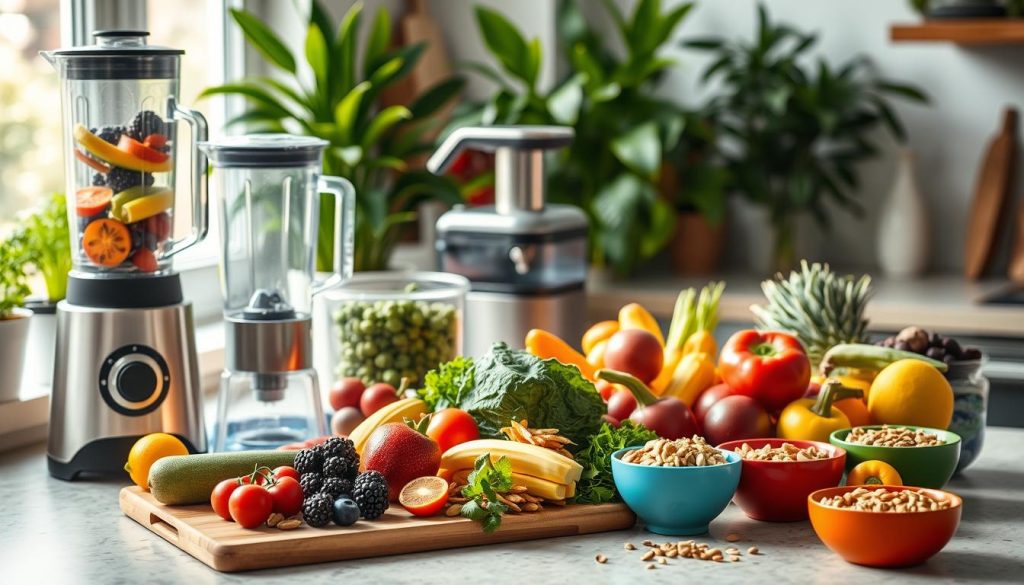
| Appliance | Purpose |
|---|---|
| High-Speed Blender | Smoothies, sauces, nut butters |
| Food Processor | Slicing, shredding, pureeing |
| Dehydrator | Preserving delicate greens, herbs, fruits |
| Vegetable Spiralizer | Creating veggie noodles |
| Nut Milk Bag | Making homemade nut milk and raw juice |
| Mandoline Slicer | Precise, paper-thin vegetable slices |
| Germination Trays | Sprouting seeds and grains |
Raw Food: Building Blocks of Natural Wellness
The raw food lifestyle centers around fresh fruits, raw vegetables, nutrient-dense nuts and seeds, and sprouted grains. These ingredients form the foundation of a holistic wellness approach. They provide essential vitamins, minerals, and phytochemicals. Embracing the raw food philosophy can lead to a transformative journey towards optimal health and vitality.
Fresh raw fruits and raw vegetables are not just visually appealing. They are packed with vital nutrients. From leafy greens to juicy berries, these foods offer antioxidants, fiber, and essential nutrients. They support overall health and well-being.
Nuts and seeds are also crucial, known for their healthy fats, proteins, and micronutrients. Raw almonds and chia seeds, for example, provide sustained energy and nourishment. They can be easily added to a raw food diet.
Sprouted grains enhance the raw food experience. They offer enzymes, vitamins, and minerals, often lacking in non-sprouted grains. These living foods are perfect for raw salads, smoothies, and other dishes, making them essential for a raw food lifestyle.
By combining these raw, whole foods, you can create a balanced and nourishing diet. This diet supports your overall well-being. Exploring raw food opens up a world of natural wellness, empowering you to thrive.
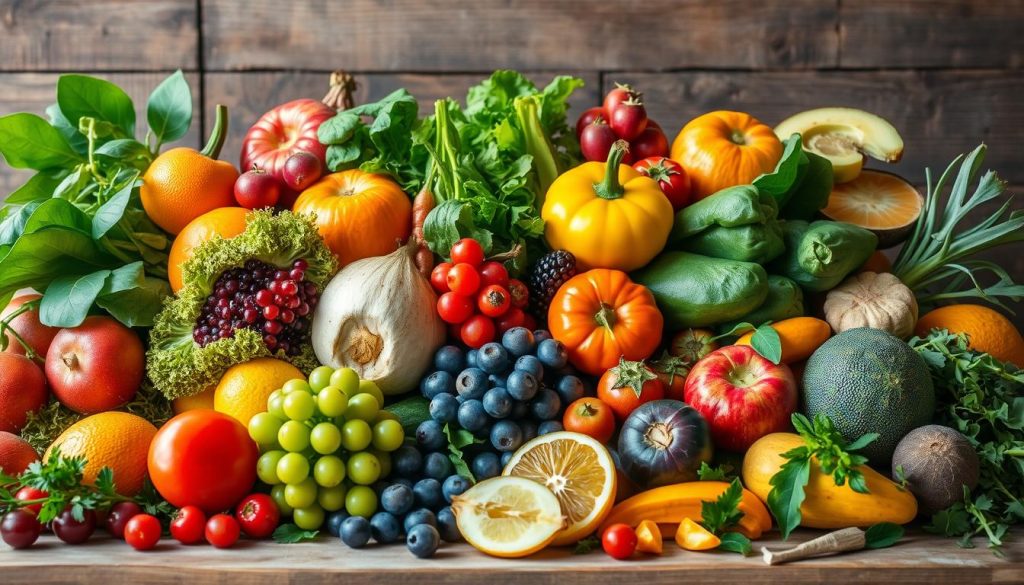
| Ingredient | Nutritional Highlights | Benefits |
|---|---|---|
| Fresh Fruits | High in vitamins, minerals, fiber, and antioxidants | Support immune function, promote skin health, and aid digestion |
| Raw Vegetables | Rich in nutrients, enzymes, and phytochemicals | Boost energy levels, improve gut health, and reduce inflammation |
| Nuts and Seeds | Packed with healthy fats, proteins, and essential minerals | Provide sustained energy, support brain function, and contribute to heart health |
| Sprouted Grains | High in enzymes, vitamins, and bioavailable nutrients | Enhance digestion, boost nutrient absorption, and promote overall vitality |
Transitioning to a Raw Food Lifestyle
Adopting a raw food diet can be a life-changing move towards better health and vitality. It’s a path open to both seasoned health buffs and newcomers alike. The journey to a raw food lifestyle demands thoughtful planning and a positive outlook. Here’s a step-by-step guide to ease your transition into this exciting new chapter.
Step-by-Step Guide to Beginning
- Start Slowly: Gradually add more raw, whole foods to your diet. This approach helps your body adapt and finds enjoyable ways to include raw elements in your meals.
- Educate Yourself: Explore the realm of raw food nutrition. Learn about the benefits of raw food diet, clean eating, and mindful eating. Discover how food combinations enhance nutrient absorption.
- Invest in the Right Tools: Stock your kitchen with essential appliances and tools. These include high-speed blenders, food processors, and dehydrators, making raw food prep easier.
- Experiment with Recipes: Try various raw food recipes that match your taste and dietary needs. This ensures you enjoy the flavors and textures of your new lifestyle.
Common Challenges and Solutions
Switching to a raw food lifestyle may face some hurdles, but with the right approach, you can conquer them. Common obstacles include:
- Cravings for Cooked Foods: Fulfill these cravings with raw alternatives like zucchini noodles or raw nut-based sauces. This helps ease the transition.
- Difficulty Dining Out: Look for raw-friendly restaurants or prepare your own healthy and nutritious meals when eating out.
- Lack of Variety: Explore a wide variety of raw fruits, vegetables, nuts, seeds, and sprouts. This keeps your meals interesting and diverse.
Creating a Sustainable Routine
To maintain a sustainable raw food lifestyle, find a balance that suits you. Use meal planning, batch cooking, and time-saving methods to simplify raw food prep. Connect with a supportive community of like-minded individuals. This keeps you motivated and inspired on your journey towards a healthy lifestyle and clean eating.
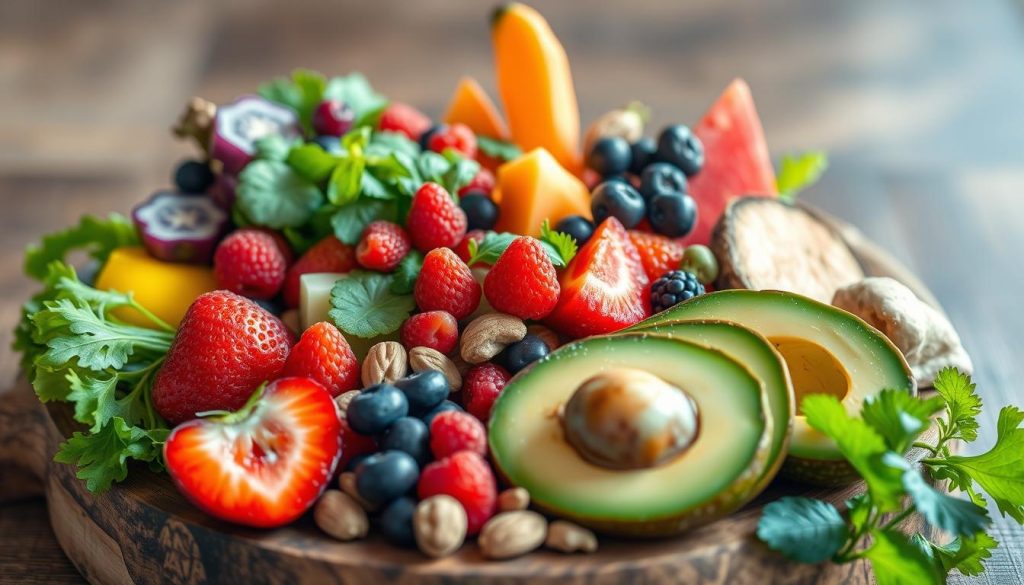
“The more you eat raw foods, the more you crave them. It’s a beautiful thing.” – Unknown
Nutrient Preservation Techniques in Raw Food
In the realm of raw food preparation, it’s crucial to preserve the natural nutrients and enzymes in fresh ingredients. Fortunately, several techniques can enhance nutrient retention and digestibility in culinary raw foods. Let’s delve into the most effective raw food techniques for maintaining ingredient integrity.
Soaking and Sprouting
Soaking nuts, seeds, grains, and legumes before consumption boosts their nutrient retention. This simple step breaks down antinutrients, making nutrients more accessible. Sprouting further activates enzymes and increases vitamin and mineral content in these food processing essentials.
Fermentation
Fermentation is a key component in a raw food meal plan. It allows fruits, vegetables, and other ingredients to ferment, enhancing their probiotic content and improving digestibility. This process also preserves a wide range of vital nutrients.
| Technique | Benefits | Examples |
|---|---|---|
| Soaking | Increased nutrient bioavailability, breakdown of antinutrients | Nuts, seeds, grains, legumes |
| Sprouting | Enzyme activation, enhanced vitamin and mineral content | Wheat berries, lentils, almonds |
| Fermentation | Improved digestibility, probiotic content, nutrient preservation | Sauerkraut, kimchi, kefir |
By using these nutrient preservation techniques in your raw food preparation, you can maximize the nutritional value of your ingredients. This ensures you enjoy the most nutritious and delicious raw food meals.
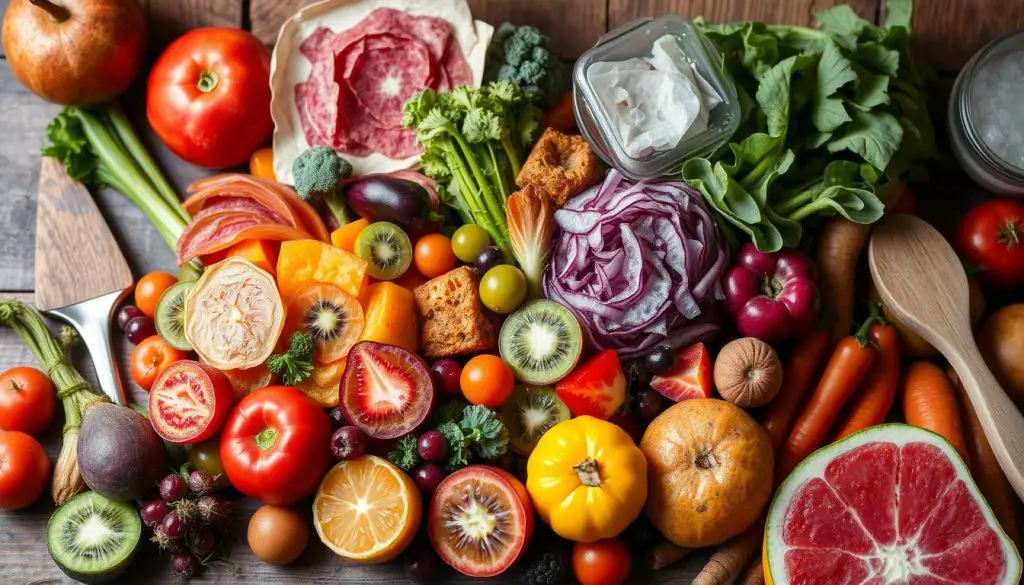
Raw Food Meal Planning and Preparation
Adopting a raw food lifestyle demands careful meal planning and efficient preparation methods. Mastering these skills allows you to fully benefit from raw, whole food nutrition. It also saves you time and effort in the kitchen.
Weekly Meal Planning Strategies
Effective weekly meal planning is crucial for a consistent raw food diet. Begin by evaluating your schedule to find slots for raw meals and snacks. Use a meal planning template or app to organize your raw dishes. This ensures a balanced and varied diet.
- Batch prepare raw staples like nut butters, veggie noodles, and dehydrated crackers for easy assembly during the week.
- Schedule specific days for more time-intensive raw food preparation, such as making raw desserts or complex salads.
- Keep a running list of your favorite raw food recipes and rotate them through your weekly plan.
Food Combinations for Optimal Nutrition
Strategic pairing of raw foods can enhance their nutritional value. Experiment with flavors, textures, and nutrient profiles to create meals and snacks that work well together.
- Combine raw leafy greens with creamy avocado or nut-based dressings to enhance the absorption of fat-soluble vitamins.
- Pair raw fruits and vegetables with raw nuts or seeds for a balanced, energy-boosting snack.
- Incorporate superfoods like raw cacao, spirulina, or maca powder into your raw desserts or smoothies for a nutrient-dense treat.
Time-Saving Preparation Tips
Streamlining your raw food preparation can save time and support a sustainable lifestyle. Use these tips to boost your kitchen efficiency.
| Time-Saving Tip | Benefit |
|---|---|
| Invest in a high-quality food processor or high-speed blender | Quickly create raw food sauces, dips, and dressings |
| Utilize a dehydrator for making raw crackers, chips, and fruit leathers | Preserve the integrity of raw ingredients while creating shelf-stable snacks |
| Prep and store washed, chopped produce in airtight containers | Reduce prep time for raw meals and ensure fresh ingredients are always on hand |
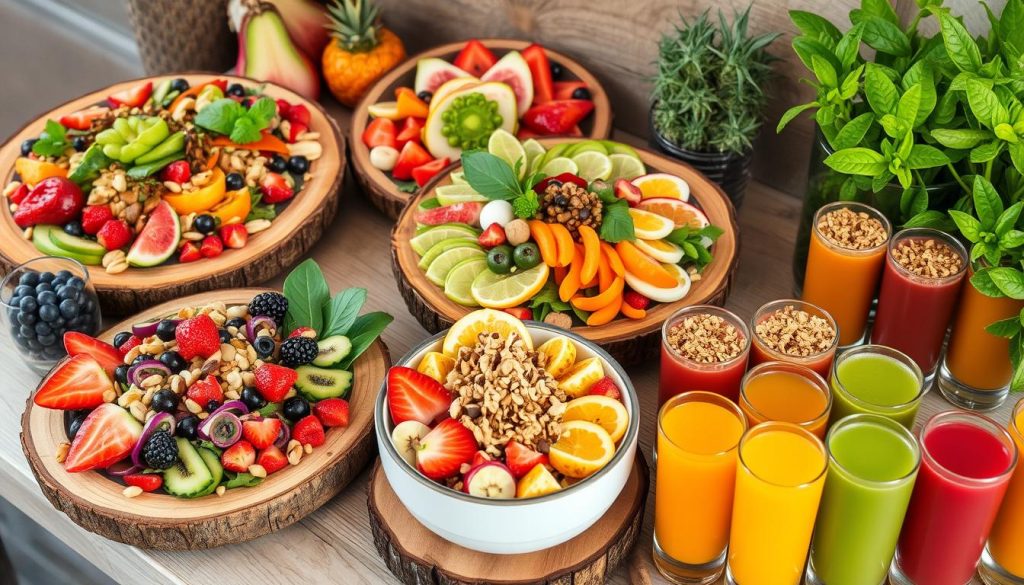
By adopting these strategies for raw food meal planning and preparation, you can enjoy a nutrient-dense lifestyle. This approach minimizes kitchen time and effort. Experiment with different recipes, combinations, and techniques to suit your lifestyle and preferences.
Superfoods and Their Role in Raw Nutrition
In the realm of raw food nutrition, superfoods stand out as the elite. These nutrient-dense powerhouses not only enhance the taste of your meals but also offer numerous health benefits. From the antioxidant-rich organic food like goji berries to the energy-boosting plant nutrition of chia seeds, adding these superfoods to your raw diet can elevate your wellness journey.
Nutritional yeast has become a favorite among many. It’s loaded with B-vitamins, protein, and a cheesy flavor. This versatile ingredient can add depth to your raw dishes. Sprinkle it on salads, mix into nut-based dips, or create a creamy, dairy-free cheese sauce for raw veggie noodles.
Cacao, the raw and unprocessed form of chocolate, is another superfood that deserves attention. It’s a rich source of herbal nutrition, packed with antioxidants, magnesium, and mood-boosting compounds. Enjoy raw cacao nibs or try raw cacao powder in smoothies, energy bars, or even raw chocolate truffles.
- Goji berries: These are a versatile organic food packed with vitamins, minerals, and antioxidants. Enjoy them in salads, snacks, or raw desserts.
- Chia seeds: These tiny energy foods are a powerhouse of omega-3s, fiber, and protein. They’re great for adding to raw meals and snacks.
- Spirulina: This nutrient-dense plant nutrition is rich in vitamins, minerals, and antioxidants. It’s easy to add to smoothies, juices, or raw energy bites.
By embracing the vibrant world of superfoods, you can unlock a new level of raw nutrition and enhance your overall well-being. Experiment with these nutrient-dense gems and discover their transformative power in your raw food lifestyle.
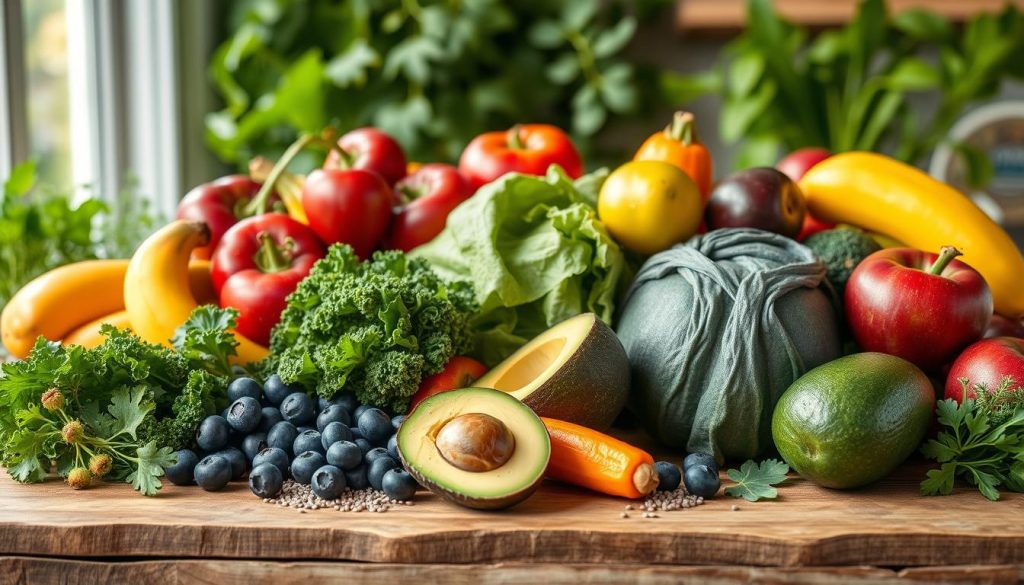
Raw Food Recipes for Every Season
Adopting a raw food lifestyle doesn’t mean sacrificing taste or seasonal variety. Raw food celebrates the natural essence of fresh, locally-sourced ingredients. It offers a range of dishes, from light spring and summer delights to warm autumn and winter treats. Our collection of raw food recipes promises to satisfy your taste buds and nourish your body, regardless of the season.
Spring and Summer Favorites
As temperatures rise, our palates yearn for vibrant, crisp tastes. Enjoy a creamy raw avocado gazpacho or a zesty raw mango and lime smoothie to refresh you. For a healthy snack, our raw fruit skewers with a honey-nut dipping sauce are perfect.
Autumn and Winter Delights
With the air growing cooler and days shorter, our bodies seek more substantial foods. Treat yourself to a decadent raw cacao and hazelnut tart or a comforting raw butternut squash soup. For a quick energy boost, try a raw beet and ginger smoothie.
Year-Round Staples
Some raw food recipes are timeless, enjoyed throughout the year. Stock your pantry with raw energy bars for a quick snack or make a batch of raw granola to top your favorite fruits and yogurt. The classic raw veggie platter with a creamy cashew-based dip is always a hit.
Let nature’s bounty guide your raw food creations. Whether you’re an experienced raw food blogger or new to the scene, these recipes will keep you enjoying the health benefits of raw food all year.
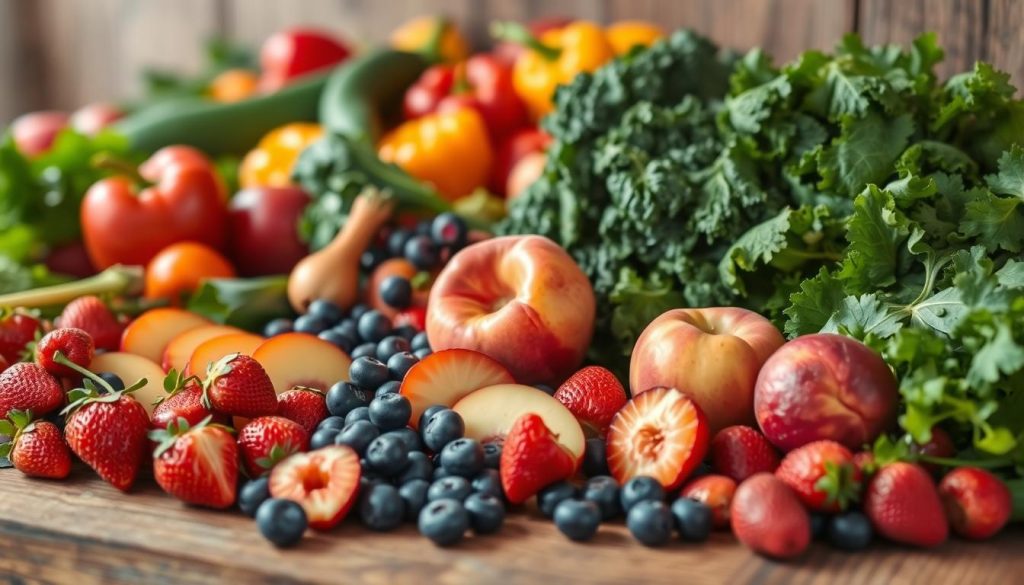
Understanding Enzyme Activity in Raw Foods
Enzymes are the unsung heroes of raw food nutrition. These powerful biomolecules play a vital role in digestion and nutrient absorption. This makes raw foods a superior source of nourishment. Unlike cooked or processed foods, raw ingredients retain their enzymatic nutrition. They provide a treasure trove of natural enzymes that aid the body’s metabolic processes.
When we consume live foods, the enzymes present help break down complex macronutrients. They transform these into simpler, more readily absorbable forms. This enhanced nutrient preservation ensures our bodies can maximize the benefits of essential vitamins, minerals, and phytonutrients found in raw produce, nuts, seeds, and sprouts.
- Enzymes are responsible for catalyzing vital biochemical reactions in the body.
- Raw foods retain their enzyme content, whereas cooking and food processing can deactivate or destroy these delicate compounds.
- Consuming enzyme-rich raw foods supports healthy digestion, nutrient absorption, and overall natural remedies for well-being.
The power of enzymes cannot be overstated. By incorporating more raw, uncooked ingredients into our diets, we can unlock the full potential of enzymatic nutrition. This allows us to reap the boundless benefits of a vibrant, plant-based lifestyle.
“The key to unlocking the true nutritional value of our food lies in preserving the delicate enzymes that nature has so carefully endowed it with.” – Dr. Edward Howell, pioneer of the raw food movement

Social Aspects of Raw Food Living
The raw food movement is expanding, reshaping the social scene for those adopting this lifestyle. The raw food community has grown, offering a rich array of resources and support. It caters to those interested in exploring this unique diet and way of life.
Workshops and educational events are at the heart of the raw food community. These events serve as a hub for enthusiasts to connect, learn, and exchange stories. They range from practical cooking sessions to in-depth talks on raw nutrition’s science. These workshops meet the increasing demand for sustainable eating and alternative diets.
Yet, embracing raw food living socially comes with its own set of obstacles. It can be tricky to stick to a raw diet when dining out or at social events. The raw food community has developed strategies to overcome these challenges. It empowers individuals to proudly follow their lifestyle choices, while also building strong connections with others.
The trend towards sustainable eating and alternative diets is clear, with the raw food community at its forefront. This community is a beacon for those seeking a more natural, nutrient-dense way of eating. Through its support network and educational offerings, it’s shaping a future where raw food is more than just a diet—it’s a lifestyle that honors the power of natural, unprocessed foods.
“The raw food community is more than just a diet – it’s a way of life that connects us to the Earth and to each other.” – Olivia Greenfield, Founder of Raw Food Workshops
Raw Food for Special Dietary Needs
The versatility of raw food nutrition goes beyond the general population. It offers tailored solutions for those with diverse dietary requirements. Athletes, individuals with age-specific nutritional needs, or those managing medical conditions can all benefit. The raw food lifestyle can be adapted to meet a wide range of special dietary needs.
Athletes and Active Lifestyles
A well-planned raw food diet is essential for athletes and those with active lifestyles. It provides the necessary fuel and recovery support. Vegan nutrition and macrobiotic diet principles, when combined with raw food, meet the increased energy and nutrient demands of an active body. Raw foods are rich in enzymes, vitamins, and minerals, aiding in muscle repair, joint health, and overall endurance.
Age-Specific Considerations
- Growing children and adolescents benefit from raw foods’ nutrient-dense properties. These support their developing bodies and cognitive functions.
- Raw food diets offer older adults the nourishment needed to maintain muscle mass, bone density, and overall vitality. They also address low-carb diet and detox diet needs.
Medical Conditions and Raw Food
Raw food diets may help manage certain medical conditions. They offer natural remedies for inflammatory disorders, autoimmune diseases, and digestive issues. By focusing on whole, unprocessed foods, raw food enthusiasts can avoid additives, preservatives, and harmful compounds that may worsen health concerns.
It’s vital to consult with healthcare professionals before starting a raw food diet for specific medical needs or dietary restrictions. They can provide tailored guidance, ensuring the safe and effective integration of raw food principles into one’s lifestyle.

Environmental Impact of Raw Food Choices
Adopting a raw food lifestyle significantly impacts the environment. It reduces dependence on processed and packaged foods, promoting a sustainable food system. Raw food diets focus on organic, locally-sourced ingredients, aligning with the increasing demand for sustainable eating.
Raw foods require minimal processing and packaging, conserving natural resources and lowering carbon emissions. The emphasis on plant-based eating in raw diets also reduces the need for resource-intensive animal products. This shift towards sustainable and eco-friendly options highlights the raw food movement’s role in making a difference.
Raw food enthusiasts enjoy both personal health benefits and a positive environmental impact. Their choice to eat organic, locally-sourced, and minimally processed foods contributes to a sustainable food system. As the need for sustainable eating grows, the raw food community leads the way in this crucial movement.
FAQ
What is a raw food diet?
A raw food diet emphasizes uncooked, unprocessed, and mainly plant-based foods. It aims to keep natural enzymes, vitamins, and nutrients intact in fresh ingredients.
What are the benefits of a raw food diet?
Adopting a raw food diet may improve digestion and boost energy. It can also reduce inflammation and enhance overall health. Raw foods are packed with enzymes, antioxidants, and other nutrients that support health.
What are the essential tools and equipment for raw food preparation?
Key appliances for raw food preparation include high-speed blenders, food processors, dehydrators, and juicers. Tools like spiralizers, nut milk bags, and germination trays are also useful for processing and preparing raw foods.
How do I transition to a raw food lifestyle?
Transitioning to raw foods gradually is advisable. Start by adding more raw fruits, vegetables, nuts, and seeds to your meals. Experiment with recipes and adjust to new textures and flavors. Create a routine that suits your lifestyle.
What are the key components of a raw food diet?
The core of a raw food diet consists of fresh fruits, vegetables, nuts, seeds, sprouted grains, and superfoods. These ingredients provide essential nutrients, enzymes, and phytochemicals for health and well-being.
How can I preserve the nutrients in my raw food?
Soaking, sprouting, and fermenting can enhance nutrient preservation and digestibility in raw foods. These methods improve nutrient bioavailability and support a balanced diet.
What are some seasonal raw food recipes I can try?
Raw food recipes are available throughout the year, tailored to each season. Enjoy refreshing smoothies and salads in spring and summer, and hearty soups and stews in autumn and winter. Using seasonal produce maximizes nutritional benefits.
How do enzymes play a role in raw food nutrition?
Enzymes are crucial for nutrient digestion and absorption. Raw foods are rich in enzymes, which are lost or diminished by cooking. Eating enzyme-rich raw foods supports digestive health and nutrient use.
How can I adapt a raw food diet to my specific dietary needs?
Raw food diets can be customized for various needs, like athletes, older adults, or those with medical conditions. Always consult healthcare professionals to ensure your diet meets your nutritional needs.
What is the environmental impact of a raw food lifestyle?
A raw food diet can positively affect the environment. It involves less processing, packaging, and transportation, reducing carbon footprint. Emphasizing local, organic produce further enhances sustainability.





